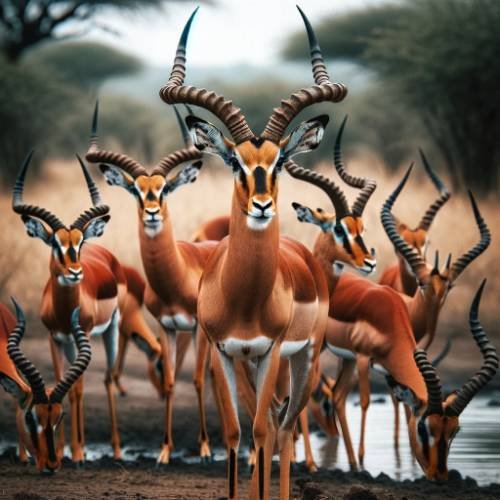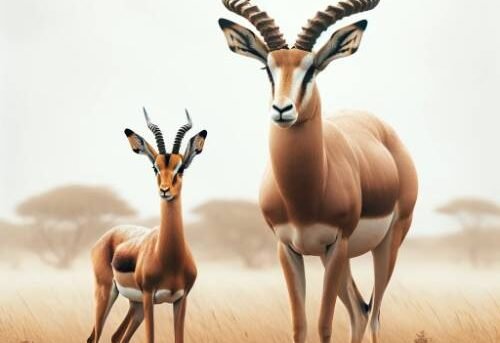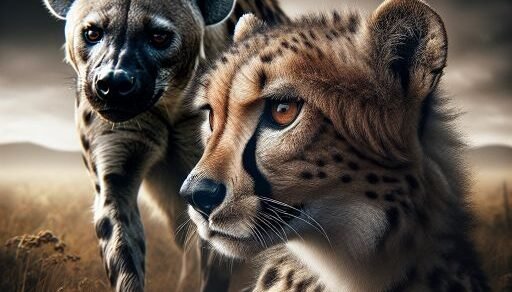In the African savanna, gazelles and impalas are often easily confused due to their similar appearance and behaviors. However, these two species have distinct differences in size, horn structure, diet, and social behavior. This article provides a detailed comparison of gazelles and impalas, focusing on their physical attributes, roles in the ecosystem, survival strategies, and interactions with predators. Understanding these differences is key to appreciating the diversity and adaptability of wildlife in the savanna.
Physical Description
Gazelles, members of the ‘Gazella’ genus, are smaller, typically standing 60-70 cm at the shoulder with a weight range of 15-75 kg depending on the species. They have slender builds, long legs, and either spiraled or lyre-shaped horns. Their coats vary from light brown to reddish, often with distinctive stripes or spots.

Impalas (‘Aepyceros melampus’), are slightly larger, standing 75-95 cm at the shoulder and weighing between 40-80 kg. Only males have horns, which are longer and more lyre-shaped than those of gazelles, reaching up to 90 cm. Impalas have a reddish-brown coat, with lighter flanks and a distinctive black stripe running from the tail to the back of each thigh.

Habitat and Diet
Gazelles inhabit various landscapes across Africa, from savannas to deserts. They are predominantly grazers, feeding on grasses, but can adapt to browse leaves during harsh conditions. This adaptability allows them to survive in both lush and arid environments.
Impalas are more water-dependent and are typically found in savannas close to water sources. They are mixed feeders, grazing on grass and browsing on leaves, shoots, and fruits, which provides them with a nutritional advantage during different seasons.
Behavior and Social Structure
Gazelles often form herds, with social structures varying by species. Some are territorial, while others form loose groups, especially during migrations. They rely on their exceptional speed, up to 100 km/h in short bursts, to evade predators.
Impalas live in two types of social groups: female herds with offspring and bachelor groups. Males are territorial during mating seasons, displaying their strength and agility to attract females and deter rivals. Impalas can leap up to 3 meters in height and 10 meters in distance, a skill used for both evading predators and social display.
Role in Ecosystem and Predation
Gazelles and impalas are key prey species in African ecosystems, supporting predators like lions, leopards, cheetahs, and wild dogs. Their grazing and browsing habits influence vegetation patterns, impacting the ecological balance.
As Prey Species:
- Food Web Support: Gazelles and impalas are crucial in sustaining the population of several apex predators. Lions, leopards, cheetahs, and African wild dogs rely heavily on these antelopes as a food source. The hunting strategies and population dynamics of these predators are closely tied to the availability and behavior of gazelles and impalas. For instance, the speed and agility of gazelles challenge cheetahs to evolve and maintain their incredible hunting speeds.
- Population Control and Balance: Predation on gazelles and impalas naturally regulates their populations, preventing overgrazing. This control is vital for maintaining a balanced ecosystem where plant life and other animal species can thrive.
Influencing Vegetation Patterns:
- Grazing and Browsing Habits: Gazelles, primarily grazers, consume grasses, playing a role in controlling grassland overgrowth. This grazing pattern can prevent bush encroachment, a significant ecological issue in some savanna regions. By keeping the grass short, they maintain the savanna’s grassland ecosystem, which benefits a range of species from insects to birds and other mammals.
- Seed Dispersal and Plant Growth: Impalas, which are mixed feeders, contribute to both grassland and woodland ecosystems. Their browsing helps shape the woody vegetation structure. Additionally, as they move across different areas, they aid in seed dispersal through their feces, contributing to plant diversity and growth.
- Soil Impact: The movement and feeding habits of these animals also indirectly affect soil composition and health. Their hooves aerate the soil, and their droppings serve as a natural fertilizer, enhancing soil fertility, which in turn supports plant growth.
In summary, the presence and behaviors of gazelles and impalas have far-reaching impacts on their environment. They not only serve as essential components of the food web but also as stewards of the land, shaping the vegetation and soil health, which are critical for a healthy and balanced savanna ecosystem.
Survival and Defense Mechanisms
Gazelles primarily rely on their speed and agility to escape predators. They are vigilant and have excellent vision, which helps them spot threats early.
Impalas use both speed and their remarkable jumping ability to evade predators. Their unpredictable leaping makes them more difficult targets for predators like cheetahs, which rely on speed and surprise.
Combat and Defense
In terms of combat, both species use their horns as weapons. Gazelle males may engage in horn wrestling during mating rituals or territorial disputes. Impala males, with their larger and more robust horns, engage in more intense fights for dominance and access to females.
Hypothetical Encounter
In a hypothetical encounter between a gazelle and an impala, several factors would influence the outcome. The impala’s larger size and more robust horns give it a physical advantage. However, gazelles are quicker and more agile, which could help them evade direct confrontation. In a fight, the impala might have a higher chance of winning due to its physical attributes, but gazelles would likely avoid combat altogether, relying on their speed for defense.




